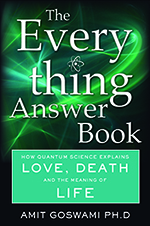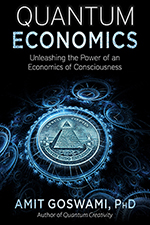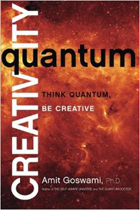The Dalai Lama once said something to this effect, “No model of reality is complete without quantum physics.” It is most important to comprehend this message. So, this is where I will begin.
If science were normal today, and if we lived in normal times, part of what I have to relate in this article would be the subject of a press release. It would read like this:
“New neuroscience data confirms that each human being has a quantum self besides the more familiar ego self and that it is commensurate with a cognitive-behavioral conceptualization of consciousness. This two-selves model is a major prediction of the new quantum science of the self proposed in 1989 in a paper appearing in an obscure physics journal. However, the idea was widely circulated via the seminal book The Self-Aware Universe byAmit Goswami, PhD. The quantum self has connotations of spiritual oneness. The existence of it was pronounced in the Upanishads—the Sanskrit word for it is antaratman—some five thousand years ago. The two-selves (one transpersonal; one personal) model is also the conceptual basis of transpersonal psychology, a force in psychology that came into being in the 1960s. Hence, we are witnessing the birth of an integral view of the human being within modern scientific thinking. Consciousness is the ground of all being; all experiences come from quantum possibilities of consciousness from which to choose.”
Yet we don’t live in normal times, and science is no longer pursued in a bias-free manner; witness the rise of scientific materialism. Its underlying philosophy, that all is matter moving in space andtime, was unambiguously overruled by an experiment conducted by Alain Aspect et al in 1982 which demonstrated quantum nonlocality—signal-less instantaneous communication. In spite of this demonstration that such instant communication implies a domain of potential oneness as predicted by quantum mathematics back in 1925-26, most scientists still wear the straightjacket of scientific materialism even when they study consciousness! They cannot discern the anachronism in their thinking.
You, with a post-materialist context of thinking, must appreciate the fact that this obtuseness has a very simple reason behind it. Materialist scientists do not have any unambiguous experience of the subject-pole of their experience. The fact is this: the subject pole of the ordinary ego experience is so overwhelmed by previous memory that it is almost implicit in the form of what materialists do acknowledge and call the “qualia” of an experience. However, in this implicit form, consciousness seems a manageable concept, manageable within the philosophy of the world conceived as material objects. They call it the “hard” problem.
In this way, all post materialist thinking must begin with an explicit acknowledgement of the subject-pole of an experience. You can do this best if you, with the help of what is called mindfulness meditation, fall into the expansion of consciousness that the subject-pole represents for you. Then you can appreciate the opening that quantum physics creates for you: on one hand, quantum physics gives you oneness of a domain of potentiality; on the other hand, your own experience gives you the subject-object polarity of experiences. So the question of quantum measurement is this: How does the oneness become two—subject and object?
This is the true measurement problem and all materialists try to camouflage the question (actually the physicist John von Neumann raised the question in the above form decades ago) tooth and nail by creating diversionary tactics: Hence, we have all those other so-called solutions of the quantum measurement problem which only explain the manifestation of objects. See that and dispel your assumption that the solution of the quantum measurement problem that I proposed in the 1990s is one of many solutions. It is the one and only solution!
Can Quantum Physics Apply to Us?
The materialist has one legitimate concern. Quantum physics was discovered in connection with our scientific search for a theory of behavior of the submicroscopic base level of matter. Matter is reductionist, bulk matter can be reduced to elementary particles; and vice versa, bulk matter can be built from elementary particles. No doubt that ultimately, quantum physics rules all matter, micro and macro. However, for practical purposes, we must recognize that for bulk matter Newton’s dynamics approximately holds. This, too, is part of the quantum dynamics applied to matter.
What this means is that at the bulk macro level, matter is still wave like, but the wave nature is much subdued leaving consciousness with very little possibility to choose from. Face it; bulk matter is largely independent of consciousness and creativity.
So, what makes us think that somehow quantum physics applies to bulk living matter though its effect is negligible on bulk non-living matter? As I have said in the very beginning of the consciousness-in-science movement, back in the 1990s, living matter is different, it has vitality. A living body is a dynamic duo of a physical component and a vital component. It is the vital component that is quantum; the physical is quantum by association.
To understand things better, a little more quantum physics is needed. As I said before, the turning point for our understanding of quantum physics came with the 1982 experimental data of Alain Aspect and his collaborators. But the latter is only a verification of a 1935 theoretical idea of three physicists: Albert Einstein, Boris Podolsky, and Nathan Rosen. This EPR message is crucial to understanding quantum physics, fortunately not their mathematics.
(I once met Boris Podolsky’s son, a fellow named Pan Podolsky. He claimed that his father Boris, at the time a graduate student of Einstein, had the original idea which Einstein and his post-doc Nathan Rosen abducted, a frequent complaint of graduate students.)
The message of EPR is simple: if two quantum objects—waves of possibility—come close and interact they become correlated; nowadays, we say entangled. What this means is that they develop an unusual purely quantum characteristic of instant communication which remains in tact even when they are not interacting, even when they move far away, even galaxies apart, from each other. We call such instant communication nonlocal.
Uncorrelated objects in space and time are particles, and, thus, they do not have this characteristic. Objects in space and time require signals to communicate; signals have a speed limit, the speed of light. Signals travel with a finite speed taking a finite time from one locality to another through the intervening space. So objects in space and time generally are objects with separateness.
In contrast, if the waves of potentiality are correlated, then, when they are actualized as particles, their behavior indicates that they have communicated instantly, without signals. How could they have done that? Because, you must realize, the correlation or entanglement made them into one. One does not need a signal to communicate with itself. Their oneness reflects the oneness of consciousness—the domain of potentiality; consciousness maintains their oneness even at a distance.
The oneness of the domain of potentiality is a potential oneness. EPR gave us the clue how to actualize and thereby verify the oneness via measurements in space and time.
Now let’s go back to conceptualizing the vital-physical duo, living bodies, as correlated quantum objects. They are one. When a physical organ carries out a function, we experience the movement of its correlated vital organ. The experience of this movement is called feeling. Vitality, call it vital energy, is a feeling, correct?
We are saying vital movements are quantum; therefore, the movements of physical living bodies, the organs, are also quantum by virtue of correlation. But how do we empirically know that vital movements are quantum movements?
There is a signature. Look at a physical object, say a chair, and imagine that a friend of yours is also looking at the chair. Although, the movement of the chair is ultimately quantum, and the center of mass of the chair does move by a measly 10-17 cm (don’t worry, it has been measured by lasers), such small movements are quite invisible to your naked eye. So you and your friend see the chair at the same place, and since this is shareable information, you conclude that the chair must be outside of you. In this way you see the material world at the macro-level as outside of you.
In contrast, how do you experience feelings? As private and internal, right? This is because feelings are quantum. Between your feeling and your friend’s feeling, the potentialities of movement of the vital organ have changed so much that the two of you cannot likely actualize the same manifest feeling. In other words, you usually cannot share the same feeling with a friend. Feelings are private and cognized as internal.
The mystic poet Kabir wrote:
Thinkers, listen, tell me what you know of that not inside the soul?
Take a pitcher full of water and set it down on the water—
now it has water inside and water outside.
We mustn’t give it a name,
lest silly people start talking again about the body and the soul.
(Bly, 1977.)
What is Kabir trying to say? That it is all consciousness, both psyche and soma. The difference between the water outside and the water inside arises from the glass boundary of the pitcher. The difference of psyche and soma arises from the different ways we experience them: We experience the physical world of soma as external to us, but we also experience an internal world of awareness which, then, we call the psyche.
Some of you, especially if you are a male, may be a little skeptical about the experience of feeling, but don’t be. You, generally speaking, experience feeling mixed with thought; the mixture we call emotion. Emotions bring us passion, the juice of life. It’s the feeling in emotion that does it, that brings the juice.
Amazingly, the ancient wisdom traditions somehow intuited all this. In wisdom traditions, they always theorize that the Oneness, which is called the causal domain of reality, comes down to the material level (called the gross level) via an intermediary—called the subtle level. The subtle consists of not only the vital but also the mental with which we think (meaning) and the supra-mental with which we intuit (archetypal contexts of elevated thinking and feeling such as truth, love, beauty, goodness, and wholeness).
Thinking about meaning is important for our well being. When you are baffled and cry out “What is the meaning of my life?” and no answer comes, you hit despair and become susceptible to disease. And intuitions are invitations to explore the archetypes like love; they give our lives purpose. That, too, is essential for well-being.
It fits. Like feeling, we experience thoughts and intuitions internally as well, don’t we? They, too, are quantum.



